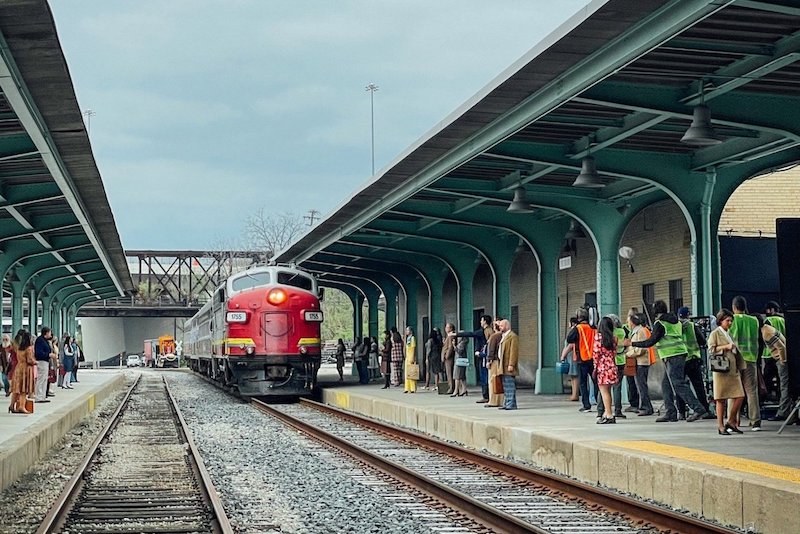By Eric Berger
In scenes that recall a vanquished Pittsburgh area commuter service, a former Algoma Central FP9 and classic passenger equipment appear in the new Tom Hank movie, “A Man Called Otto.”
Though the two sequences involving railroad scenes are relatively brief, a perhaps surprising amount of effort and resources were involved in making it happen.
“The train work in this picture helps form the narrative heart of the movie, but we knew it would be very challenging to serve our specific creative ambitions while remaining both on budget and on schedule,” explains John Adkins, locations manager for the movie.
Enter Kelly Lynch of railroad consulting firm FMW Solutions, who coordinated the use of equipment and locations with the Potomac Eagle Scenic Railway, Cuyahoga Valley Scenic Railroad, and the Washington D.C. Chapter of the National Railway Historical Society.
Lynch had extensive experience with both railroads and the film industry when he joined FMW in 2021. His work on an Amazon series in Pittsburgh led to the recommendation that he be brought in for the Hanks film.
The trains scenes drew inspiration from the Mon Valley Commuter Rail service operated by Port Authority of Allegheny County in the Monongahela Valley from 1975 to 1989. To portray the train, Lynch lined up an FP-9A locomotive from Potomac Eagle and former MARC and Pennsylvania Railroad commuter cars.
In the role of Pittsburgh Union Station, Lynch cast the art deco-styled Central Union Terminal in Toledo, Ohio, which was free of the various logistical issues that precluded the use of the Pittsburgh station. “The station and period trains were a perfect match,” said Louise Rosner, executive producer.
“Once we confirmed the Toledo Port Authority owned the platforms and actual trackage, we knew we had three tracks and 4,000 feet of the railroad to operate on without encumbering the nearby mainline or disrupting Amtrak’s passenger operations,” Lynch stated.
Filming took place over three days, at three different locations. The first was a day of exterior aerial work in Romney, W. Va., featuring the Potomac Eagle locomotive and stainless steel passenger cars at their home base.
“Tourist railroads and museums are great assets that can usually be very accommodating within reason,” Lynch added.
Filming continued on the Cuyahoga Valley Scenic Railroad, where interior scenes were shot in a modified Budd RDC-3 as it was pulled through Cuyahoga National Park. The depowered RDC was selected because its spartan character was reflective of passenger rail in that era.
“Every movie train is special, though generally, productions want either steam locomotives or modern freight or passenger trains,” added Lynch. “This is an era of passenger rail rarely seen on film. In some cases, car interiors were rejected because they were restored and looked too nice.”
The film team reunited with the FP-9A in Toledo. Coordinating with the Port Authority, Norfolk Southern and Amtrak, Lynch isolated the platforms, imported station props from Mad River & NKP Railroad Museum and conducted safety briefings with a cast of over 160 performers for the third and final day of shooting.
“The local Norfolk Southern crews were critical to ensuring the production could select Toledo as a location, as they worked with us to ship, switch, and position the equipment so that our teams could take over,” Lynch said.
Others FMW credited for work on the project were Mid America Railcar, Carload Express, Mad River & NKP Railroad Museum, Horizon Rail, Fort Wayne Railroad Historical Society, McRail Insurance, Brian Smith, and Chris Homco.



